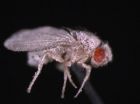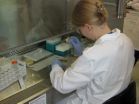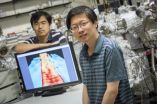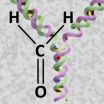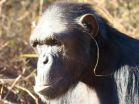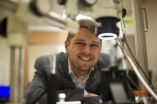(Press-News.org) Before you swat away the next fruit fly, consider instead just how similar its biological complexities are to our own. In a study published in PLOS ONE, researchers led by Deborah Kimbrell, Ph.D., at the University of California, Davis (UC Davis) and their collaborators, studied how microorganisms may alter fruit flies' immunity in space and in hypergravity, or increased gravity. The article is titled "Toll Mediated Infection Response Is Altered by Gravity and Spaceflight in Drosophila."
This study suggests that having normal gravity or hypergravity on the space station may help mitigate some of the biological problems, including weakened immune response, in organisms living in space. Since fruit flies have similar immune response mechanisms to humans, this knowledge may help NASA create specialized countermeasures to keep astronauts healthy during long-duration space missions to an asteroid or Mars.
Knowledge that spaceflight weakens the human immune system obtained from years of research in microgravity has led scientists to use model organisms similar to humans to test out various scenarios of disease or weakened immunity in spaceflight. Model organisms, such as plants, fruit flies or microbes like yeast, advance our understanding of the influence of microgravity on cells. Taking these organisms to space allows for examination of growth and development and physiological, psychological and aging processes without the impact of gravity.
"What we don't realize in our everyday lives is that every biological, chemical and physical process that takes place in our terrestrial environment of Earth happens under the influence of gravitational forces," explained Camille Alleyne, Ed.D., space station assistant program scientist at NASA's Johnson Space Center in Houston. "Conducting scientific investigations on the space station, such as that on the fruit flies, allows us to remove that gravitational element from the equation, and advances our knowledge about these same processes that lead to amazing breakthroughs and discoveries."
Drosophila melanogaster - the common fruit fly - was used in this study, due to its similar human immune function qualities, sharing characteristics of cellular and humoral, or extracellular fluids, immunity and signaling pathways. The fruit fly makes such a great model, in fact, that NASA developed a new Fruit Fly Lab in 2014 to accommodate continued study of Drosophila. This facility will support longer duration studies involving multiple generations of fruit flies.
Kimbrell was one of the earliest investigators into Drosophila immunity. As senior researcher in the Department of Molecular and Cellular Biology at UC Davis, she brought Drosophila immunity into space exploration-related studies. Though fruit fly immunity had been studied on Earth, its immunity had not been studied using hypergravity or spaceflight. Kimbrell and her team of researchers wanted to test the immune response of fruit flies impacted by changes in gravity at the organismal level.
"Immune response is central to health for essentially all organisms, and, not surprisingly, in the stressful space environment there are a variety of changes to how a person or other organisms can fight an infection," explained Kimbrell. "In order to try and understand those changes, my group used the simple fruit fly, well-studied for its immune response on Earth, as a model to help sort out at a cell-based level what happens to the immune response when an organism is in space."
There are two main signaling pathways, Toll and Imd, which act as the go-betweens of immune response to fungal and bacterial infections in fruit flies. In humans, Toll counterparts are known as Toll-like receptors (TLRs), since a 2011 Nobel Prize-winning team discovered the Toll pathway response to immunity first in fruit flies. Humans and other mammals share these two immunity response pathways with fruit flies. Given these similarities, Kimbrell examined the fruit fly immune response from exposure to hypergravity, and then microgravity. Her goal was to see what possible links could be established to the human immune response during spaceflight.
The fruit flies were exposed to hypergravity on a centrifuge at UC Davis. The results found from study in hypergravity led to the spaceflight investigation, Fungus, Immunity and Tumorigenesis (FIT), during space shuttle Discovery's STS-121 mission to the International Space Station in 2006. The 12-day mission allowed a small population of fruit flies to fully develop into adults in space. The flies were then returned to Earth for further analysis and comparison of the effects of two extreme environments on these living organisms.
Researchers discovered that hypergravity and microgravity produced opposite cell-based responses in fruit fly immunity. When exposed to increased gravity, the flies responded to infection by a fungus, Beauveria bassiana, using the Toll pathway. This was in direct contrast to the flies flown in space, since the space flies' Toll pathway failed to respond to the exact same type of fungal infection. However, the Imd pathway response to E. coli bacteria was robust in flies exposed to hypergravity and microgravity.
"What we found is that in one kind of infection in flies that were raised in space, they did fine, and in another kind of infection, they really didn't respond at all," said Kimbrell. "The pathway that did not respond, the Toll pathway, is critical in humans for all kinds of health-related issues, both for functioning and for over-functioning. The Toll pathway (TLR4) response is involved in sepsis, which is still a big problem in human health."
In fact, when the flies infected with a fungus were exposed to increased gravity, they survived significantly better than flies with the same infection at normal gravity, suggesting a boost to their Toll pathway response. The exception to enhanced Toll pathway response in hypergravity was in fruit flies with the mutant yuri gagarin gene. This Drosophila mutant immune response mutant studied on Earth was used to distinguish between host and fungal response to gravity. The mutant is named for the first man in space, cosmonaut Yuri Gagarin, because it has difficulty sensing gravitational fields. Mutant immune response to fungal infection was the same at normal gravity and hypergravity, indicating an association between gravity and the immune response.
Kimbrell described the possible implications of this increased gravity effect on immunity. The idea that even short-term exposure to increased gravity during a ride on a roller coaster could potentially have a positive effect on immune response in humans comes from the boost demonstrated in fruit fly immunity during hypergravity exposure.
"I'm trying to encourage Drosophila investigators to conduct their research on the space station, not just looking at immunity or following up on our research," said Kimbrell. "I think research in space is very important. Looking further into investigations where fruit flies and other organisms develop in space and are infected in space will start to sort out what is really going on."
Kimbrell is working on a new investigation with fruit flies that she hopes will be selected for study aboard the space station in the future. With research like that of Kimbrell's team, similar future space investigations will help prepare astronauts for long-duration missions farther into the solar system than ever before and bring better understanding of immune system response on Earth.
INFORMATION:
Fruit fly immunity fails with fungus after (space)flight
2014-07-03
ELSE PRESS RELEASES FROM THIS DATE:
Drug shows promise for effectively treating metabolic syndrome
2014-07-03
(SALT LAKE CITY)—University of Utah researchers have discovered that an enzyme involved in intracellular signaling plays a crucial role in developing metabolic syndrome, a finding that has a U of U spinoff company developing a drug to potentially treat the condition.
The researchers, led by Jared Rutter, Ph.D., professor of biochemistry, hope to begin human clinical trials of a drug in the next couple of years.
"The approved drug therapies do not treat or prevent this condition in most people," says Rutter, senior author of a study describing the research published ...
With 'ribbons' of graphene, width matters
2014-07-03
MILWAUKEE – Using graphene ribbons of unimaginably small widths – just several atoms across – a group of researchers at the University of Wisconsin-Milwaukee (UWM) has found a novel way to "tune" the wonder material, causing the extremely efficient conductor of electricity to act as a semiconductor.
In principle, their method for producing these narrow ribbons – at a width roughly equal to the diameter of a strand of human DNA – and manipulating the ribbons' electrical conductivity could be used to produce nano-devices.
Graphene, a one-atom-thick sheet of carbon atoms, ...
Bone marrow fat tissue secretes hormone that helps body stay healthy
2014-07-03
ANN ARBOR, Mich. — It has been known for its flavorful addition to soups and as a delicacy for dogs but bone marrow fat may also have untapped health benefits, new research finds.
A University of Michigan-led study shows that the fat tissue in bone marrow is a significant source of the hormone adiponectin, which helps maintain insulin sensitivity, break down fat, and has been linked to decreased risk of cardiovascular disease, diabetes, and obesity-associated cancers. The findings appear in today's online-ahead-of-print issue of Cell Metabolism.
Bone marrow adipose ...
NASA sees Hurricane Arthur's cloud-covered eye
2014-07-03
When NASA's Aqua satellite passed over Tropical Storm Arthur on July 2 at 2:50 p.m. EDT on July 2, it saw a cloud-covered eye as the storm was on the way to becoming a hurricane.
This visible image of Tropical Storm Arthur was captured by the Moderate Resolution Imaging Spectroradiometer or MODIS instrument that flies aboard NASA's Aqua satellite. Arthur's center was over the Atlantic Ocean and east of Florida's northeast coast. By 5 a.m. EDT on July 3, Arthur's eye had formed but remained cloud covered even as the storm hit hurricane-strength with maximum sustained ...
Cellular defence against fatal associations between proteins and DNA
2014-07-03
This news release is available in German.
DNA - the carrier of genetic information - is constantly threatened by damage originating from exogenous and endogenous sources. Very special DNA lesions are DNA-protein crosslinks - proteins covalently linked to DNA. So far hardly anything was known about repair mechanisms specifically targeting DNA-protein crosslinks. Stefan Jentsch's team at the Max Planck Institute of Biochemistry in Martinsried, Germany, now discovered a protease that is able to chop down the protein component of DNA-protein crosslinks, thereby enabling ...
'Grass-in-the-ear' technique sets new trend in chimp etiquette
2014-07-03
Chimpanzees are copycats and, in the process, they form new traditions that are often particular to only one specific group of these primates. Such are the findings of an international group of scientists, who waded through over 700 hours of video footage to understand how it came about that one chimpanzee stuck a piece of grass in her ear and started a new trend, and others soon followed suit. The findings of the study, led by Edwin van Leeuwen of the Max Planck Institute for Psycholinguistics in The Netherlands, are published in Springer's journal Animal Cognition.
In ...
GW researchers: Acute kidney injury and chronic kidney disease as interconnected syndromes
2014-07-03
WASHINGTON (July 3, 2014) — For more than 40 years, physicians have treated diminished kidney function as two distinct syndromes: acute kidney injury (AKI) and chronic kidney disease (CKD). However, recent epidemiologic and mechanistic studies suggest the two syndromes are not distinct entities, but interconnected. Published today in The New England Journal of Medicine, George Washington University (GW) researchers call for greater follow-up care of patients with AKI, who often present with CKD later in life, and vice versa.
"Our teaching has been wrong and the approach ...
Weighing up the secrets of African elephant body fat
2014-07-03
A research team from The University of Nottingham has carried out the first molecular characterisation of the African elephant's adipose tissue — body fat. This new information will form the basis of future studies aimed at securing the health and future survival of captive elephants.
The population of captive elephants, both Asian and African, in Europe and North America is not self-sustaining, largely due to poor fertility, resulting in a fewer baby elephants being born. It is acknowledged that if a solution for these reproductive difficulties cannot be found quickly, ...
Identifying microbial species
2014-07-03
Millions of microbial species populate the world, but so far only a few have been identified due to the inability of most microbes to grow in the laboratory. Edgar Goluch, an engineer, and Slava Epstein, a biologist, aim to change this. The pair, both researchers at Northeastern University, has developed a device that allows scientists to cultivate a single species of bacteria that can then be studied and identified.
Goluch's previous research devices incorporated permeable membranes that allow sequestered bacteria to be exposed to the nutrients and molecules of their ...
Women veterans want options, follow up support when dealing with intimate partner violence
2014-07-03
(Boston)--Intimate partner violence (IPV) is a significant health issue faced by women veterans, but little has been known up until now about their preferences for IPV-related care. A new study has found that most of these women support routine screening for IPV and want options, follow-up support, transparent documentation and Veterans Health Administration (VHA) and community resources. These findings appear in the journal Research in Nursing and Health.
Although women of all socio-demographic groups are at risk for IPV, population-based research suggests that women ...
